Young Japanese and traditions
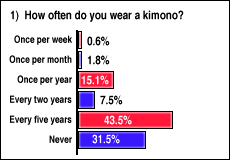 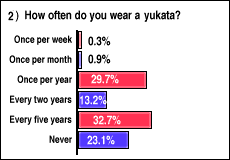  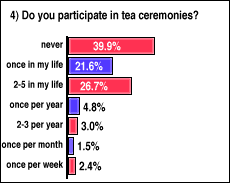 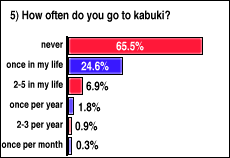  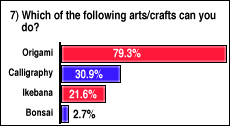 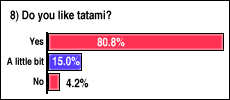 |
Many non-Japanese people associate Japan with arts, crafts and traditions such as the tea ceremony, kimono and kabuki. In this month's survey, we wanted to find out how today's young Japanese relate to those traditions.
In our first question, we asked the survey participants how frequently they wear kimono. One out of three respondents indicated that they have never worn a kimono. 43.5% indicated to put on a kimono only about once every five years. Only 2.4% of the respondents wear a kimono more than once per year. Accordingly, only about one out of five respondents indicated to be able to put on a kimono by him/herself.
Women wear kimono more frequently than men. Among men, as many as 68.7% have never worn a kimono, compared to 19.2% among women.
As for yukata, a cheaper cotton version of the kimono, the percentages look quite similar, but yukata enjoy a little bit greater popularity than kimono. After all, one third of the respondents indicated to wear a yukata once per year. On the other hand, over 50% wear yukata as infrequently as once every 5 years or less.
The yukata, too, is more popular among women than men. A surprising 41% of male respondents have never worn a yukata, compared to 17.2% of female respondents.
One of the most famous Japanese traditions among foreigners is the tea ceremony. According to our survey, a minority of 39.9% have never participated in a tea ceremony. 11.7% participate in a tea ceremony once per year or more - 2.4% even once per week. About half of the respondents have participated between one and five times. The tea ceremony is more popular among women than men, however, the differences between the genders is not very large.
Two out of three of the survey respondents never went to see a kabuki play, a traditional kind of Japanese theatre. Another 31.5% have seen kabuki between one to five times in their lives. The remaining 3% go to see kabuki once per year or even more frequently.
As for traditional music instruments, 11.4% of the survey participants answered that they can play the taiko drum which seems to be more popular among men (16.9%) than women (9.6%). 10.2% play the koto, a zither with 13 strings. The koto is played by more women (11.2%) than men (7.2%). The Shakuhachi flute, on the other hand, is played by 7.2% of male survey participants, but only 0.4% of the women. As for the Shamisen, 2.4% of the participants indicated to be able to play it.
We also asked our survey participants whether they practice traditional Japanese arts and crafts. A large majority of 79.3% responded that they can do origami, the art of paper folding. This craft is more popular among women (85.2%) than men (61.5%). Calligraphy, is practiced by 30.9% of the respondents. This art, too, is practiced by more women (34.4%) than men (20.5%). While almost one out of three women do Ikebana, the art of flower arranging, only 1.6% of men do so. On the other hand, the art of cultivating miniature trees (bonsai) is clearly more popular among men (6.0%) than women (1.6%).
Finally we asked the survey participants whether they like tatami mats. 80.8% responded positively, 15.0% just like them a little bit, and only 4.2% dislike the straw mats.
Questions? Ask in our forum.

